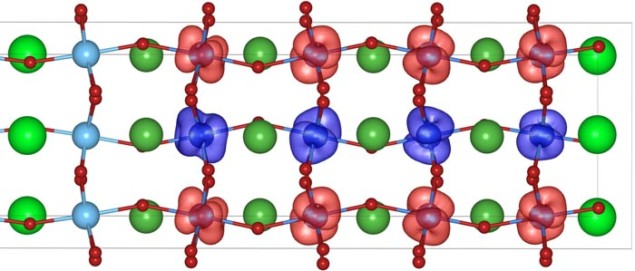
A new type of solar cell that relies on a surprising property of certain insulators has been proposed by physicists in Austria, the US and Germany. The design relies on the discovery a decade ago that the interface between two insulating oxides can become metallic, which could eliminate the need for metal wires in solar cells. If the cost of producing layered structures of the oxides can be reduced, the research could lead to a new type of highly efficient photovoltaic cell.
In 2004 Harold Hwang and Akira Ohtomo made the remarkable discovery that when a layer of the insulator lanthanum titanate was grown on the insulator strontium titanate, a 2D electron gas forms at the interface causing it to become metallic. The phenomenon is caused by the accumulation of charge at the edge of a polar oxide as it meets a non-polar oxide. It has since been seen in other oxide interfaces and has been investigated by multiple research groups trying to develop new and improved electronic devices.
Conducting interfaces
Now, an independent team of researchers at the Vienna University of Technology, the Oak Ridge National Laboratory and the University of Würzburg has done calculations that suggest that the effect could be used to create a new type of solar cell – one in which the generated current is extracted via conducting interfaces rather than with metal wires.
Solar cells rely on the photoelectric effect, where a photon striking an electron in the valence band of a material promotes it to the conduction band, leaving a positively charged “hole”. The electrons and holes must be removed from the photovoltaic material without recombining or dissipating their energy into lattice vibrations.
Polar oxides such as lanthanum titanate contain an internal electric field and positively and negatively charged planes of atoms. Oak Ridge’s Satoshi Okamoto and colleagues reasoned that this polarization would help separate the electrons and the holes before they could recombine. If such a polar oxide is paired with the appropriate non-polar oxide, the interfaces would be metallic. As a result, electrons and holes could be extracted from either side of the device without covering the surface with wires, which block some of the light from reaching the active region of the cell.
Maximizing absorption
The researchers first needed a polar oxide that would absorb as much solar energy as possible. A material’s band gap is the energy difference between its valence and conduction bands. Photons with energies less than the band gap cannot create electron–hole pairs, whereas photons with energies greater than the band gap will create pairs. In the latter case, however, energy in excess of the band gap is lost as heat. As a result, the band gap should therefore be low enough to absorb plenty of solar photons, but high enough to extract as much energy as possible from the photons absorbed.
The researchers settled on lanthanum vanadate, which has an band gap of 1.1 eV – visible light is in the 1.5–3.5 eV energy range. They used density functional theory to model the behaviour of a solar cell constructed of a layer of lanthanum vanadate grown on a strontium titanate substrate. While they were unable to make precise predictions about device efficiency based on their results, the researchers suggest that the inherent advantages of the design deserve further investigation.
Capturing higher-energy photons
The researchers also suggest that the efficiency of the solar cell could be increased further by incorporating a layer of lanthanum ferrate on top of the lanthanum vanadate. Lanthanum ferrate has a band gap of 2.2 eV, so higher-energy photons could be captured in this layer, leaving the lower-energy photons to be captured by the lanthanum vanadate. A project to produce prototype solar cells is under way at the University of Würzburg.
Optimistic but cautious
Okamoto is cautiously optimistic about whether the solar cells could ever be efficient enough to make them economically viable. “They could become competitive, but it will take quite a long time,” he says. “Currently, only a limited number of facilities can grow this kind of heterostructure using very advanced thin-film growth methods. I hope that when people fully understand how best to grow these solar cells the cost will come down.”
Neil Greenham, who works on novel solar cells at the University of Cambridge, describes the research, published in Physical Review Letters, as “an interesting theory paper” but emphasizes it will be impossible to assess whether or not the solar cells will have any practical advantages over current designs until working prototypes are produced. He also questions the assertion that simply incorporating two epitaxial layers could allow electron–hole pairs to be collected with two different energies, suggesting that, unless the electron–hole pairs could be extracted separately, any extra energy captured by an electron in lanthanum ferrate would be dumped into the lattice as it passed through the lanthanum vanadate.
Okamoto responded that photogenerated electrons and holes should cross a thin film of lanthanum vanadate in “a few femtoseconds”, which is less than the time it would take to lose energy to the lattice.



